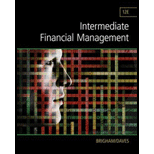
Concept explainers
Define each of the following terms:
- a. Weighted average cost of capital, WACC; after-tax cost of debt, rd(1 – T); after-tax cost of short-term debt, rstd(1 – T)
- b. Cost of
preferred stock , rps;cost of common equity (or cost of common stock), rs - c. Target capital structure
- d. Flotation cost, F; cost of new external common equity, re
a)
To discuss: Weighted average cost of capital (WACC), after-tax cost of debt rd (1-t) and after tax cost of short term debt rstd (1-t).
Explanation of Solution
Weighted average cost of capital is nothing but minimum (expected) required rate of return and it is also called as cut of rate. It includes cost of all sources like common stock, bonds in long term and preferred stock that are weighted proportionately while calculating weighted average cost of capital.
After tax cost of debt rd (1-t), is the applicable cost to the company for new financing of debt. For this purpose, interest that accrues on debt is allowed as deduction for tax purposes.
If a company has short-term period debt with a cost of rstd, then it’s after tax cost is rstd (1-t), is the proper cost of debt.
b)
To discuss: Cost of preferred cost (rps) and cost of common equity (rs).
Explanation of Solution
Cost of preferred stock is nothing but the cost of issuing new preferred stock by company. For perpetual preferred, it is nothing but preferred dividend divided by net issue price.
Cost of common equity is nothing but the cost of equity obtained by selling new common stocks of a company. It is basically, the cost of retained earnings income adjusted for floating costs. Floating costs are incurred when the company issues new securities for the first time.
c)
To discuss: Target capital structure.
Explanation of Solution
The target capital structure is nothing but the relative amount of debt, common equity and preferred stock that an organization desires. Calculation of weighted average cost of capital is totally based on these target weights.
d)
To discuss: Flotation cost and cost of new external common equity.
Explanation of Solution
The concept of floatation cost is considered when a company issues a new security. This includes fees paid to investment bankers and other legal fees. The cost of new common equity is better than that of not unusual equity raised internally by reinvesting earnings. The projects financed with external equity must earn higher returns, since the projects must cover these flotation costs.
Want to see more full solutions like this?
Chapter 11 Solutions
Intermediate Financial Management (MindTap Course List)
- Delta Company, a U.S. MNC, is contemplating making a foreign capital expenditure in South Africa. The initial cost of the project is ZAR11,000. The annual cash flows over the five-year economic life of the project in ZAR are estimated to be 3,300, 4,300, 5,290, 6,280, and 7,250. The parent firm's cost of capital in dollars is 9,5 percent. Long-run inflation is forecasted to be 3 percent per annum in the United States and 7 percent in South Africa. The current spot foreign exchange rate is ZAR per USD = 3.75. Required:. Calculating the NPV in ZAR using the ZAR equivalent cost of capital according to the Fisher effect and then converting to USD at the current spot rate. - NPV in USD using fisher effect Converting all cash flows from ZAR to USD at purchasing power parity forecasted exchange rates and then calculating the NPV at the dollar cost of capital. - NPV in USD using PPP rates Are the two USD NPs different or the same? What is the NPV in dollars if the actual pattern of ZAR per…arrow_forwardWhat is the 50/30/20 budgeting rule in finance?arrow_forwardHow do student loans impact long-term financial health?arrow_forward
- With regard to foreign currency translation methods used by foreign MNCs, Multiple Choice a. foreign currency translation methods are generally only used by U.S. based MNCs since foreign firms have a built-in hedge by being foreign. b. are generally the same methods used by U.S.-based firms. c. are exactly the same methods used by U.S.-based firms since GAAP is GAAP. d. none of the options.arrow_forwardCray Research sold a supercomputer to the Max Planck Institute in Germany on credit and invoiced €11.60 million payable in six months. Currently, the six-month forward exchange rate is $1.18 per euro and the foreign exchange adviser for Cray Research predicts that the spot rate is likely to be $113 per euro in six months.Required: a. What is the expected gain/loss from a forward hedge?Note: A Negative value should be indicated with a minus sign. Do not round intermediate calculations. Round your final answer in whole dollars not in millions.arrow_forwardWhat is the time value of money and how is it calculated? need answer!arrow_forward
 Intermediate Financial Management (MindTap Course...FinanceISBN:9781337395083Author:Eugene F. Brigham, Phillip R. DavesPublisher:Cengage LearningPrinciples of Accounting Volume 2AccountingISBN:9781947172609Author:OpenStaxPublisher:OpenStax College
Intermediate Financial Management (MindTap Course...FinanceISBN:9781337395083Author:Eugene F. Brigham, Phillip R. DavesPublisher:Cengage LearningPrinciples of Accounting Volume 2AccountingISBN:9781947172609Author:OpenStaxPublisher:OpenStax College Cornerstones of Financial AccountingAccountingISBN:9781337690881Author:Jay Rich, Jeff JonesPublisher:Cengage Learning
Cornerstones of Financial AccountingAccountingISBN:9781337690881Author:Jay Rich, Jeff JonesPublisher:Cengage Learning



